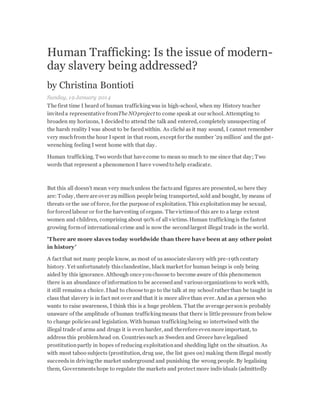
chris art 3
- 1. Human Trafficking: Is the issue of modern- day slavery being addressed? by Christina Bontioti Sunday, 19 January 2014 The first time I heard of human traffickingwas in high-school, when my History teacher inviteda representative fromThe NOproject to come speak at our school. Attempting to broaden my horizons, I decidedto attend the talk and entered, completely unsuspecting of the harsh reality I was about to be facedwithin. As cliché as it may sound, I cannot remember very muchfrom the hour I spent in that room, except for the number '29 million' and the gut- wrenching feeling I went home with that day. Human trafficking. Two wordsthat have come to mean so much to me since that day; Two words that represent a phenomenon I have vowedto help eradicate. But this all doesn't mean very muchunless the factsand figures are presented, so here they are: Today, there are over 29 million people being transported, sold and bought, by means of threats or the use of force, for the purpose of exploitation. This exploitationmay be sexual, for forcedlabour or for the harvesting of organs. The victimsof this are to a large extent women and children, comprising about 90% of all victims. Human traffickingis the fastest growing formof international crime and is now the secondlargest illegal trade in the world. 'There are more slaves today worldwide than there have been at any other point in history' A fact that not many people know, as most of us associate slavery with pre-19thcentury history. Yet unfortunately thisclandestine, black market for human beings is only being aided by this ignorance. Although once youchoose to become aware of this phenomenon there is an abundance of information to be accessedand variousorganizations to work with, it still remains a choice. I had to choose to go to the talk at my schoolrather than be taught in class that slavery is in fact not over and that it is more alive than ever. Andas a person who wants to raise awareness, I think this is a huge problem. That the average personis probably unaware of the amplitude of human traffickingmeans that there is little pressure from below to change policiesand legislation. With human traffickingbeing so intertwined with the illegal trade of arms and drugs it is even harder, and therefore evenmore important, to address this problemhead on. Countriessuch as Sweden and Greece have legalised prostitutionpartly in hopes of reducing exploitationand shedding light on the situation. As with most taboo subjects (prostitution, drug use, the list goes on) making them illegal mostly succeedsin drivingthe market underground and punishing the wrong people. By legalising them, Governmentshope to regulate the markets and protect more individuals (admittedly
- 2. also making a profit). However, the key seems to be shifting the blame, the shame and the penalisation from the supply-side to the demand-side, as that is the one that drivesthe entire market. The sword is indeed double-edged and the solutionis not easy to find. Nonetheless, the countlessorganisations whose very aimit is to fight against human traffickingaside, there have been some effortsrecently that need to be especially acknowledged. Dutch charity Terre des Hommes createda fake profile of a simulated girl named Sweetie to attract predatorsand then give their names and locations to the police. In the US, the Contra Costa County officials have made effortsto fight human traffickingtheir priority. By raising awareness in whatever ways we can, I believe it is each of us who can help this list to continue to grow and the number of victimsbegin to reduce dramatically. For more information, please search for the following organisations: Love146, The NO Project, Somaly Mam Foundation, The A21 Campaign, International Justice Mission, UNHCR/UNODC. IMAGE SOURCES The title image for this article was sourcedfrom the International PoliticalForum website and the article image was sourcedfromthe website dreamcenter.org.